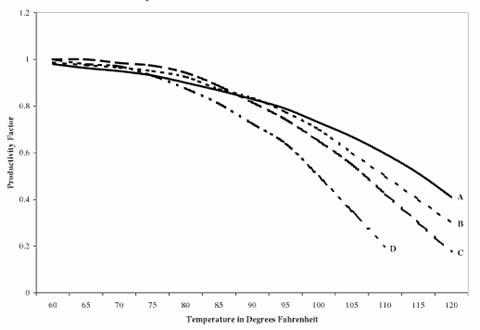
Our long holiday weekend would’ve been much more enjoyable had New York City enjoyed its typical July weather. Instead, we were slammed with a heatwave of the utmost severity, which made strolling the streets only slightly more pleasant than roaming the post-apocalyptic Outback from Mad Max: Beyond Thunderdome. And, alas, the worst is yet to come, which means another long day or two of bewailing our lack of central air conditioning.
When the mercury soars as it has, we feel entirely disinclined to work—a condition we ascribe to a fundamental flaw in our species makeup. Like all other sentient beings, we have an optimal temperature range, and excesses in either direction cause us to underperform. But by how much? As the chart above shows, tremendous effort has been exerted in the name of identifying precisely how much heat drags on productivity. Much of that work has centered on the construction industry, where productivity projections must be factored into multi-million dollar bids, and minor errors can bring about endless litigation and abrupt bankruptcy. Check out this fascinating breakdown of the various formulas used to estimate how heat turns construction workers sluggish:
U.S. Army Corps of Engineers has developed a model for calculating the productivity factor when temperatures vary. This is the factor that would be multiplied by the productivity achieved at 60 F. The model for use when [wet bulb globe temperature, or WBGT] is less than 60 F is:
P = 0.000048 WGBT + 0.0081 WGBT + 0.6875
When WGBT is greater than 60 F, the formula is:
P = 2.2 log(c) WBGT – 0.0366 WBGT – 5.8116.
The upshot is that certain construction tasks are severely impacted by hot weather, while others are less so. The smart project leader will thus reassign his crew to tackle the appropriate tasks when the heat gets nasty. But then again, that assumes a certain sensitivity on the part of management. And in some of the globe’s most sweltering regions, that may be sorely lacking.


J.D. Connor // Jul 6, 2010 at 10:13 am
That chart is full of surprises. Not surprising: painting inside falls off less than painting outside. Surprising: masonry inside falls off more; water pumping falls off a bunch, etc.
On days like this, I always think of the folks stuck doing hot-seal roofing. Is there a hotter job?
Brendan I. Koerner // Jul 6, 2010 at 10:20 am
@J.D. Connor: Yeah, that’s a pretty bad one. Especially if you’re using old-school materials, and thus standing alongside a vat of boiling tar.
I also feel bad for the brave men working New York City’s halal carts today. The one on the corner of 125th and Lenox lacks any semblance of shade, and that grill gets mighty hot…
Jordan // Jul 6, 2010 at 10:54 am
Over at Ta-Nehisi’s blog, one of the commenters related what it was like to go jogging in Dubai and pass construction workers. He was trying to burn off all the excess calories he had consumed while they were trying to burn as few calories as possible in their physically demanding job. Such are the ironies of the modern world.